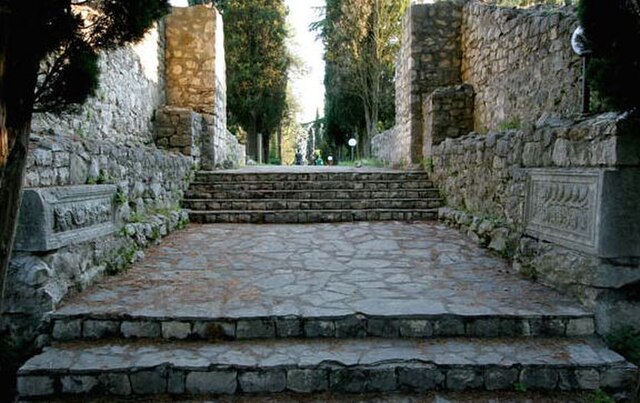Gazi Husrev-beg Mosque is a mosque in the city of Sarajevo, Bosnia and Herzegovina. Built in the 16th century, it is the largest historical mosque in Bosnia and Herzegovina and one of the most representative Ottoman structures in the Balkans. Having been Sarajevo's central mosque since the days of its construction, today it also serves as the main congregational mosque of the Muslims in Bosnia and Herzegovina. It is located in the Baščaršija neighborhood in the Stari Grad municipality and, being one of the main architectural monuments in the town, is regularly visited by tourists.
Gazi Husrev-beg Mosque from Hotel Europe
Gazi Husrev-bey's turbe (mausoleum)
The minaret with the Muezzin calling to prayer. Note the Eastern Arabic numerals on the Ottoman-era clock tower.
Gazi Husrev-beg mosque in the 19th century
Bosnia and Herzegovina, sometimes known as Bosnia-Herzegovina and informally as Bosnia, is a country in Southeast Europe, situated on the Balkan Peninsula. It borders Serbia to the east, Montenegro to the southeast, and Croatia to the north and southwest. In the south it has a 20 kilometres long coast on the Adriatic Sea, with the town of Neum being its only access to the sea. Bosnia has a moderate continental climate with hot summers and cold, snowy winters. In the central and eastern regions, the geography is mountainous, in the northwest it is moderately hilly, and in the northeast it is predominantly flat. Herzegovina, the smaller, southern region, has a Mediterranean climate and is mostly mountainous. Sarajevo is the capital and the largest city.
Iron Age cult carriage from Banjani, near Sokolac
Mogorjelo, an ancient Roman suburban Villa Rustica from the 4th century, near Čapljina
Hval's Codex, illustrated Slavic manuscript from medieval Bosnia
Gazi Husrev-beg Mosque in Sarajevo, dating from 1531







